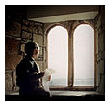The Gospel Ring (1)
Posted by Anne on Oct 7, 2015 in Naming, Writing | 4 commentsIt’s been quite some time since my last post. Perhaps I should apologise but it wouldn’t be entirely sincere. I’ve been enjoying myself far too much to even begin to be sorry.
The fun started when I forgot a significant item of information I wanted for my next book. I could remember reading somewhere that John the apostle identifies himself as the author of the fourth gospel by using a unique placement. His signoff as ‘the disciple Jesus loved’ mirrors the testimony of John the Baptist at the beginning. This bookending identifies the writer as John.
Well, being unable to remember where I’d read this, I tried googling it. No joy. I remembered the technical name for this mirror technique was chiasmus and tried that as well. Lots of different examples of mirror episodes in John’s gospel turned up but not the particular matter I wanted. After quite a bit of searching, I began to realise that the lists of chiastic scenes were rarely the same. So I created my own list by putting together the ones I’d found. And that’s when I noticed something fascinating: the names almost always match.
It’s not just the testimony of John the apostle mirroring that of John the Baptist.
It’s a scene involving Mary the mother of Jesus mirroring one with Mary Magdalene.
It’s a scene with Nicodemus matching another with the same Nicodemus.
It’s five disciples (including Nathanael) following Jesus to Galilee mirroring five sets of disciples (including Nathanael – who is never ever mentioned in Scripture, other than in these two places) following Jesus to Galilee.
There are mathematical mirrors too.
There are 17 words in the first sentence and the 17th triangular number is mentioned at the end. (This might not seem like much to us but it would have been stunning to first century Greek readers who devised their writing according to mathematical principles of beauty. It would have been revolutionary to combine the abominable number 17 with the ideal of geometric grace: the logos.)
There are 496 syllables which start the gospel and 496 words which end it.
As far as I can tell, 11 pairs of matching elements form a ring around the gospel. The only time the names don’t match perfectly is when the doubts of Nathanael at the beginning reflect the doubts of Thomas at the end. (But this disagreement is quite superficial, as it turns out. At a deeper level, the name Thomas does indeed match the name Nathanael—but that’s a story for another time.)
Now all this suggested to me that the stories were especially selected so that they would form this beautiful design—and there wouldn’t be much point in doing this for its own sake. Each episode is meant to be understood in the light of the other part of the pair, as well as the adjacent stories.
Take, for instance, Mary Magdalene meeting Jesus in the garden after His resurrection. The parallel story involves Mary, the mother of Jesus, at the wedding feast of Cana. A closer look at Mary Magdalene’s words reveals that they reflect the nuptial language of the Song of Songs. Both these incidents are about brides—and, in case a reader missed Mary Magdalene’s role as a representative of the Bride of Christ, the chiasmus was no doubt meant to reveal it.
Ok, it’s pretty subtle. So John made sure his first century readers got some blatant in-your-face messaging as well. Skip over the mirror pair of Nicodemus and there are two testimonies from a man named John. (Again!) In the first instance, John the Baptist talks all about the Bridegroom. In the second instance, John the apostle testifies to Jesus’ last words on the cross.
Brian Simmons in The Passion Translation points out that, in Aramaic, the statement ‘It is finished,’ is kalah. Which sounds exactly like kallah, ‘my bride’.
This is why he renders the words of Jesus in John 19:30 as: ‘It is finished, My bride!’
Between these two pairs of bridal allusions there is mention of Nicodemus. The first is, of course, the famous passage about being ‘born again’. And the second is about him at the Cross.
Guess what? They’re both about the Bride too!
Until next time…


WOW – impressive and thought provoking. Thank you.
Hi Ben
Thanks for dropping by. I thought the whole matter was incredibly impressive too!
I love the journeys you go on and end up on taking us readers along with you.
I enjoy the journeys, too, Dale! Make no mistake about that!